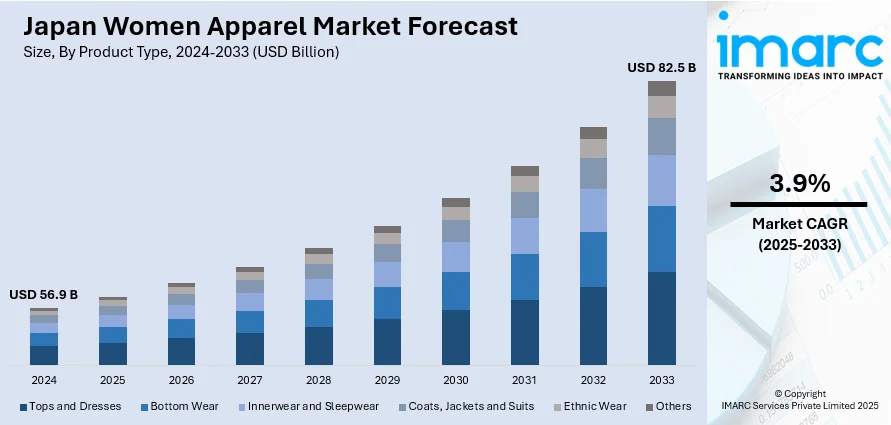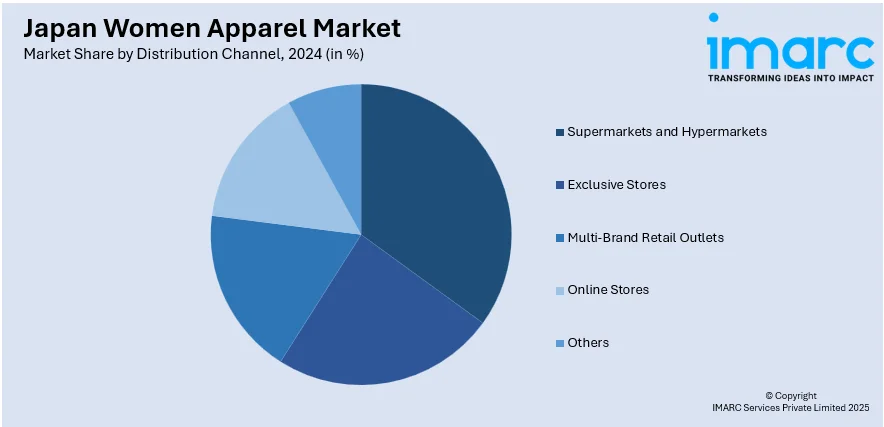
Japan Women Apparel Market Size, Share, Trends and Forecast by Product Type, Season, Distribution Channel, and Region, 2025-2033
Japan Women Apparel Market Overview:
The Japan women apparel market size reached USD 56.9 Billion in 2024. Looking forward, IMARC Group expects the market to reach USD 82.5 Billion by 2033, exhibiting a growth rate (CAGR) of 3.9% during 2025-2033. The growing demand for stylish, functional clothing, rising disposable incomes, increasing urbanization, greater female workforce participation, influence of global fashion trends, expanding fast fashion retail, aging population seeking comfortable wear, seasonal fashion cycles, and digital platforms promoting personalized shopping experiences are some of the major factors augmenting Japan women apparel market share.
|
Report Attribute
|
Key Statistics
|
|---|---|
|
Base Year
|
2024 |
|
Forecast Years
|
2025-2033
|
|
Historical Years
|
2019-2024
|
| Market Size in 2024 | USD 56.9 Billion |
| Market Forecast in 2033 | USD 82.5 Billion |
| Market Growth Rate 2025-2033 | 3.9% |
Japan Women Apparel Market Trends:
Influence of Korean and Western Fashion Trends
Japanese women’s apparel is experiencing a notable influence from both Korean and Western fashion aesthetics, which is visibly shaping design preferences and brand strategies. An industry report highlights that 75.9% of Japanese teenage girls selected Korea as the country they look to for fashion inspiration, marking the eighth consecutive year that Korea has ranked first. This trend extends beyond youth, with Korea emerging as the leading fashion reference across all age groups, from women in their teens and 20s to those in their 40s and even over 60. The consistent appeal of Korean fashion points to a deeper shift in consumer aesthetics and purchasing behavior within Japan’s women’s apparel market. This is evident in the rising popularity of soft, feminine silhouettes, pastel colors, puffed sleeves, pleated skirts, and oversized knitwear, which are hallmarks of Korean street style. Korean brands are gaining traction among younger consumers who seek trendy, affordable clothing with a distinctive cultural edge. Apart from this, Western fashion trends, particularly from the US and Europe, are also impacting the high-end and luxury segments, which is providing a boost to Japan women apparel market growth. Japanese consumers, especially millennials and Gen Z, are increasingly embracing international designer labels and Western streetwear. Moreover, global luxury brands are responding by customizing collections to match Japanese tastes, focusing on modest cuts, high-quality materials, and unique tailoring. This dual influence is creating a hybrid fashion culture where traditional Japanese aesthetics blend with global sensibilities, expanding consumer choice and encouraging cross-border brand collaborations.

Digital Transformation and E-Commerce Integration
Digital channels are becoming a critical component of the women’s apparel market in Japan, driven by the country’s high internet penetration and smartphone usage. According to an industry report, the e-commerce market in Japan is expected to reach USD 692.8 Billion by 2033, exhibiting a growth rate (CAGR) of 11.02% during 2025-2033. The growth of e-commerce platforms is redefining shopping behavior, offering convenience, competitive pricing, and access to a wide range of domestic and international brands. Retailers are enhancing the digital shopping experience through mobile apps, virtual fitting rooms, and AI-driven size recommendation tools to address the challenges of online apparel purchasing. Besides this, social commerce is also on the rise, where platforms like Instagram, LINE, and TikTok are not just marketing tools but direct sales channels. Also, influencer marketing plays a significant role in shaping brand perception and product visibility, which is positively impacting the Japan women apparel market outlook. Consumers are highly responsive to fashion influencers, especially micro-influencers who focus on niche styles. Additionally, brands are investing in omnichannel strategies, combining physical stores with integrated digital services such as click-and-collect, real-time inventory updates, and AR-powered try-ons. This evolution reflects the broader retail shift toward personalized, technology-enabled consumer engagement in Japan’s fashion sector.
Japan Women Apparel Market Segmentation:
IMARC Group provides an analysis of the key trends in each segment of the market, along with forecasts at the country level for 2025-2033.Our report has categorized the market based on product type, season, and distribution channel.
Product Type Insights:
- Tops and Dresses
- Bottom Wear
- Innerwear and Sleepwear
- Coats, Jackets and Suits
- Ethnic Wear
- Others
The report has provided a detailed breakup and analysis of the market based on the product type. This includes tops and dresses, bottom wear, innerwear and sleepwear, coats, jackets and suits, ethnic wear, and others.
Season Insights:
- Summer Wear
- Winter Wear
- All Season Wear
A detailed breakup and analysis of the market based on the season have also been provided in the report. This includes summer wear, winter wear, and all season wear.
Distribution Channel Insights:

- Supermarkets and Hypermarkets
- Exclusive Stores
- Multi-Brand Retail Outlets
- Online Stores
- Others
The report has provided a detailed breakup and analysis of the market based on the distribution channel. This includes supermarkets and hypermarkets, exclusive stores, multi-brand retail outlets, online stores, and others.
Regional Insights:
- Kanto Region
- Kansai/Kinki Region
- Central/ Chubu Region
- Kyushu-Okinawa Region
- Tohoku Region
- Chugoku Region
- Hokkaido Region
- Shikoku Region
The report has also provided a comprehensive analysis of all the major regional markets, which include Kanto Region, Kansai/Kinki Region, Central/Chubu Region, Kyushu-Okinawa Region, Tohoku Region, Chugoku Region, Hokkaido Region, and Shikoku Region.
Competitive Landscape:
The market research report has also provided a comprehensive analysis of the competitive landscape. Competitive analysis such as market structure, key player positioning, top winning strategies, competitive dashboard, and company evaluation quadrant has been covered in the report. Also, detailed profiles of all major companies have been provided.
Japan Women Apparel Market News:
- On October 4, 2024, Japan-based GU, a subsidiary of Fast Retailing and sister brand to Uniqlo, announced a collaboration with London-based designer Rok Hwang of Rokh to launch a 22-piece womenswear capsule collection. The collection, titled "Play in Style," features tailored separates and layering pieces in muted colors designed for mix-and-match versatility, with prices ranging from USD 24.99 to USD 99.99.
Japan Women Apparel Market Report Coverage:
| Report Features | Details |
|---|---|
| Base Year of the Analysis | 2024 |
| Historical Period | 2019-2024 |
| Forecast Period | 2025-2033 |
| Units | Billion USD |
| Scope of the Report |
Exploration of Historical Trends and Market Outlook, Industry Catalysts and Challenges, Segment-Wise Historical and Future Market Assessment:
|
| Product Types Covered | Tops and Dresses, Bottom Wear, Innerwear and Sleepwear, Coats, Jackets and Suits, Ethnic Wear, Others |
| Seasons Covered | Summer Wear, Winter Wear, All Season Wear |
| Distribution Channels Covered | Supermarkets and Hypermarkets, Exclusive Stores, Multi-Brand Retail Outlets, Online Stores, Others |
| Regions Covered | Kanto Region, Kansai/Kinki Region, Central/Chubu Region, Kyushu-Okinawa Region, Tohoku Region, Chugoku Region, Hokkaido Region, Shikoku Region. |
| Customization Scope | 10% Free Customization |
| Post-Sale Analyst Support | 10-12 Weeks |
| Delivery Format | PDF and Excel through Email (We can also provide the editable version of the report in PPT/Word format on special request) |
Key Questions Answered in This Report:
- How has the Japan women apparel market performed so far and how will it perform in the coming years?
- What is the breakup of the Japan women apparel market on the basis of product type?
- What is the breakup of the Japan women apparel market on the basis of season?
- What is the breakup of the Japan women apparel market on the basis of distribution channel?
- What is the breakup of the Japan women apparel market on the basis of region?
- What are the various stages in the value chain of the Japan women apparel market?
- What are the key driving factors and challenges in the Japan women apparel market?
- What is the structure of the Japan women apparel market and who are the key players?
- What is the degree of competition in the Japan women apparel market?
Key Benefits for Stakeholders:
- IMARC’s industry report offers a comprehensive quantitative analysis of various market segments, historical and current market trends, market forecasts, and dynamics of the Japan women apparel market from 2019-2033.
- The research report provides the latest information on the market drivers, challenges, and opportunities in the Japan women apparel market.
- Porter's five forces analysis assist stakeholders in assessing the impact of new entrants, competitive rivalry, supplier power, buyer power, and the threat of substitution. It helps stakeholders to analyze the level of competition within the Japan women apparel industry and its attractiveness.
- Competitive landscape allows stakeholders to understand their competitive environment and provides an insight into the current positions of key players in the market.
Need more help?
- Speak to our experienced analysts for insights on the current market scenarios.
- Include additional segments and countries to customize the report as per your requirement.
- Gain an unparalleled competitive advantage in your domain by understanding how to utilize the report and positively impacting your operations and revenue.
- For further assistance, please connect with our analysts.
 Request Customization
Request Customization
 Speak to an Analyst
Speak to an Analyst
 Request Brochure
Request Brochure
 Inquire Before Buying
Inquire Before Buying




.webp)




.webp)












